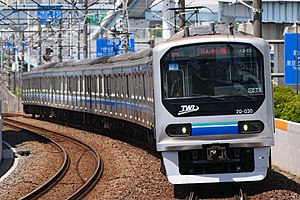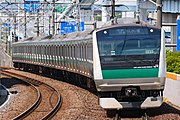Rinkai Line
| Rinkai Line | |||||||||||||||||||||||||||||||||||||||||||||||||||||||||||||||||||||||||||||||||||||||||||||||||||||||||||||||||||||||||||||||||||||||||||||||||||||||||||||||||||||||||||||||||||||||||||||||||||||||||||||||||||||||||||||||||||||||||||||||||||||||||||||||||||||||||||||||||||||||||||||||||||||||||||||||||||||||||
|---|---|---|---|---|---|---|---|---|---|---|---|---|---|---|---|---|---|---|---|---|---|---|---|---|---|---|---|---|---|---|---|---|---|---|---|---|---|---|---|---|---|---|---|---|---|---|---|---|---|---|---|---|---|---|---|---|---|---|---|---|---|---|---|---|---|---|---|---|---|---|---|---|---|---|---|---|---|---|---|---|---|---|---|---|---|---|---|---|---|---|---|---|---|---|---|---|---|---|---|---|---|---|---|---|---|---|---|---|---|---|---|---|---|---|---|---|---|---|---|---|---|---|---|---|---|---|---|---|---|---|---|---|---|---|---|---|---|---|---|---|---|---|---|---|---|---|---|---|---|---|---|---|---|---|---|---|---|---|---|---|---|---|---|---|---|---|---|---|---|---|---|---|---|---|---|---|---|---|---|---|---|---|---|---|---|---|---|---|---|---|---|---|---|---|---|---|---|---|---|---|---|---|---|---|---|---|---|---|---|---|---|---|---|---|---|---|---|---|---|---|---|---|---|---|---|---|---|---|---|---|---|---|---|---|---|---|---|---|---|---|---|---|---|---|---|---|---|---|---|---|---|---|---|---|---|---|---|---|---|---|---|---|---|---|---|---|---|---|---|---|---|---|---|---|---|---|---|---|---|---|---|---|---|---|---|---|---|---|---|---|---|---|---|---|---|---|---|---|---|---|---|---|---|---|---|---|---|---|---|---|---|---|---|
| R | |||||||||||||||||||||||||||||||||||||||||||||||||||||||||||||||||||||||||||||||||||||||||||||||||||||||||||||||||||||||||||||||||||||||||||||||||||||||||||||||||||||||||||||||||||||||||||||||||||||||||||||||||||||||||||||||||||||||||||||||||||||||||||||||||||||||||||||||||||||||||||||||||||||||||||||||||||||||||
 A TWR 70-000 series train on the Tokyo Waterfront Railway, heading towards Shin-Kiba | |||||||||||||||||||||||||||||||||||||||||||||||||||||||||||||||||||||||||||||||||||||||||||||||||||||||||||||||||||||||||||||||||||||||||||||||||||||||||||||||||||||||||||||||||||||||||||||||||||||||||||||||||||||||||||||||||||||||||||||||||||||||||||||||||||||||||||||||||||||||||||||||||||||||||||||||||||||||||
| Overview | |||||||||||||||||||||||||||||||||||||||||||||||||||||||||||||||||||||||||||||||||||||||||||||||||||||||||||||||||||||||||||||||||||||||||||||||||||||||||||||||||||||||||||||||||||||||||||||||||||||||||||||||||||||||||||||||||||||||||||||||||||||||||||||||||||||||||||||||||||||||||||||||||||||||||||||||||||||||||
| Other name(s) | R | ||||||||||||||||||||||||||||||||||||||||||||||||||||||||||||||||||||||||||||||||||||||||||||||||||||||||||||||||||||||||||||||||||||||||||||||||||||||||||||||||||||||||||||||||||||||||||||||||||||||||||||||||||||||||||||||||||||||||||||||||||||||||||||||||||||||||||||||||||||||||||||||||||||||||||||||||||||||||
| Native name | |||||||||||||||||||||||||||||||||||||||||||||||||||||||||||||||||||||||||||||||||||||||||||||||||||||||||||||||||||||||||||||||||||||||||||||||||||||||||||||||||||||||||||||||||||||||||||||||||||||||||||||||||||||||||||||||||||||||||||||||||||||||||||||||||||||||||||||||||||||||||||||||||||||||||||||||||||||||||
| Owner | Tokyo Waterfront Area Rapid Transit | ||||||||||||||||||||||||||||||||||||||||||||||||||||||||||||||||||||||||||||||||||||||||||||||||||||||||||||||||||||||||||||||||||||||||||||||||||||||||||||||||||||||||||||||||||||||||||||||||||||||||||||||||||||||||||||||||||||||||||||||||||||||||||||||||||||||||||||||||||||||||||||||||||||||||||||||||||||||||
| Locale | Tokyo | ||||||||||||||||||||||||||||||||||||||||||||||||||||||||||||||||||||||||||||||||||||||||||||||||||||||||||||||||||||||||||||||||||||||||||||||||||||||||||||||||||||||||||||||||||||||||||||||||||||||||||||||||||||||||||||||||||||||||||||||||||||||||||||||||||||||||||||||||||||||||||||||||||||||||||||||||||||||||
| Termini | |||||||||||||||||||||||||||||||||||||||||||||||||||||||||||||||||||||||||||||||||||||||||||||||||||||||||||||||||||||||||||||||||||||||||||||||||||||||||||||||||||||||||||||||||||||||||||||||||||||||||||||||||||||||||||||||||||||||||||||||||||||||||||||||||||||||||||||||||||||||||||||||||||||||||||||||||||||||||
| Stations | 8 | ||||||||||||||||||||||||||||||||||||||||||||||||||||||||||||||||||||||||||||||||||||||||||||||||||||||||||||||||||||||||||||||||||||||||||||||||||||||||||||||||||||||||||||||||||||||||||||||||||||||||||||||||||||||||||||||||||||||||||||||||||||||||||||||||||||||||||||||||||||||||||||||||||||||||||||||||||||||||
| Service | |||||||||||||||||||||||||||||||||||||||||||||||||||||||||||||||||||||||||||||||||||||||||||||||||||||||||||||||||||||||||||||||||||||||||||||||||||||||||||||||||||||||||||||||||||||||||||||||||||||||||||||||||||||||||||||||||||||||||||||||||||||||||||||||||||||||||||||||||||||||||||||||||||||||||||||||||||||||||
| Depot(s) | Yashio | ||||||||||||||||||||||||||||||||||||||||||||||||||||||||||||||||||||||||||||||||||||||||||||||||||||||||||||||||||||||||||||||||||||||||||||||||||||||||||||||||||||||||||||||||||||||||||||||||||||||||||||||||||||||||||||||||||||||||||||||||||||||||||||||||||||||||||||||||||||||||||||||||||||||||||||||||||||||||
| Rolling stock | TWR 70-000 series, E233-7000 series | ||||||||||||||||||||||||||||||||||||||||||||||||||||||||||||||||||||||||||||||||||||||||||||||||||||||||||||||||||||||||||||||||||||||||||||||||||||||||||||||||||||||||||||||||||||||||||||||||||||||||||||||||||||||||||||||||||||||||||||||||||||||||||||||||||||||||||||||||||||||||||||||||||||||||||||||||||||||||
| Daily ridership | 200,200[2] | ||||||||||||||||||||||||||||||||||||||||||||||||||||||||||||||||||||||||||||||||||||||||||||||||||||||||||||||||||||||||||||||||||||||||||||||||||||||||||||||||||||||||||||||||||||||||||||||||||||||||||||||||||||||||||||||||||||||||||||||||||||||||||||||||||||||||||||||||||||||||||||||||||||||||||||||||||||||||
| History | |||||||||||||||||||||||||||||||||||||||||||||||||||||||||||||||||||||||||||||||||||||||||||||||||||||||||||||||||||||||||||||||||||||||||||||||||||||||||||||||||||||||||||||||||||||||||||||||||||||||||||||||||||||||||||||||||||||||||||||||||||||||||||||||||||||||||||||||||||||||||||||||||||||||||||||||||||||||||
| Opened | 1996 | ||||||||||||||||||||||||||||||||||||||||||||||||||||||||||||||||||||||||||||||||||||||||||||||||||||||||||||||||||||||||||||||||||||||||||||||||||||||||||||||||||||||||||||||||||||||||||||||||||||||||||||||||||||||||||||||||||||||||||||||||||||||||||||||||||||||||||||||||||||||||||||||||||||||||||||||||||||||||
| Technical | |||||||||||||||||||||||||||||||||||||||||||||||||||||||||||||||||||||||||||||||||||||||||||||||||||||||||||||||||||||||||||||||||||||||||||||||||||||||||||||||||||||||||||||||||||||||||||||||||||||||||||||||||||||||||||||||||||||||||||||||||||||||||||||||||||||||||||||||||||||||||||||||||||||||||||||||||||||||||
| Line length | 12.2 km (7.6 mi) | ||||||||||||||||||||||||||||||||||||||||||||||||||||||||||||||||||||||||||||||||||||||||||||||||||||||||||||||||||||||||||||||||||||||||||||||||||||||||||||||||||||||||||||||||||||||||||||||||||||||||||||||||||||||||||||||||||||||||||||||||||||||||||||||||||||||||||||||||||||||||||||||||||||||||||||||||||||||||
| Track gauge | 1,067 mm (3 ft 6 in) | ||||||||||||||||||||||||||||||||||||||||||||||||||||||||||||||||||||||||||||||||||||||||||||||||||||||||||||||||||||||||||||||||||||||||||||||||||||||||||||||||||||||||||||||||||||||||||||||||||||||||||||||||||||||||||||||||||||||||||||||||||||||||||||||||||||||||||||||||||||||||||||||||||||||||||||||||||||||||
| Electrification | 1,500 V DC overhead catenary | ||||||||||||||||||||||||||||||||||||||||||||||||||||||||||||||||||||||||||||||||||||||||||||||||||||||||||||||||||||||||||||||||||||||||||||||||||||||||||||||||||||||||||||||||||||||||||||||||||||||||||||||||||||||||||||||||||||||||||||||||||||||||||||||||||||||||||||||||||||||||||||||||||||||||||||||||||||||||
| |||||||||||||||||||||||||||||||||||||||||||||||||||||||||||||||||||||||||||||||||||||||||||||||||||||||||||||||||||||||||||||||||||||||||||||||||||||||||||||||||||||||||||||||||||||||||||||||||||||||||||||||||||||||||||||||||||||||||||||||||||||||||||||||||||||||||||||||||||||||||||||||||||||||||||||||||||||||||
The Rinkai Line (りんかい
Overview[edit]
While not part of the Tokyo subway network (as it was built to JR specifications), the Rinkai Line is fully grade separated and runs underground for nearly 10 km (6.2 mi) of its 12.2 km (7.6 mi) distance, going as low as 40 meters (130 ft) below the ground when crossing under the Port of Tokyo. The Shinonome – Shin-Kiba segment (which uses the former Keiyō Freight Line) is elevated.
Station list[edit]
All stations are located in Tokyo. All trains stop at every station on the line.

| No. | Station | Japanese | Distance (km) | Transfers | Location | |
|---|---|---|---|---|---|---|
| Between stations |
Total | |||||
R01
|
Shin-Kiba | - | 0.0 |
|
Kōtō | |
R02
|
Shinonome | 2.2 | 2.2 | |||
R03
|
Kokusai-Tenjijō | 1.3 | 3.5 | |||
R04
|
Tokyo Teleport | 1.4 | 4.9 | |||
R05
|
Tennōzu Isle | 2.9 | 7.8 | MO Tokyo Monorail | Shinagawa | |
R06
|
Shinagawa Seaside | 1.1 | 8.9 | |||
R07
|
Ōimachi | 1.6 | 10.5 | |||
R08
|
Ōsaki | 1.7 | 12.2 |
| ||
| ↓ Through-running to/from Kawagoe via the Saikyō and Kawagoe Line ↓ | ||||||
Rolling stock[edit]
- TWR 70-000 series 10-car EMUs (since 1996)
- JR East E233-7000 series 10-car EMUs (since 30 June 2013)
The TWR 70-000 series electric multiple unit (EMU) trains are based at Yashio Depot, which is accessed via a spur located between Tennōzu Isle Station and Tokyo Teleport Station (the spur track also provides access to Tokyo Freight Terminal), while the E233 series trains are based at Kawagoe Depot.
The first of a fleet of 31 new 10-car E233-7000 series sets were introduced on Saikyō Line, Kawagoe Line, and Rinkai Line services between Kawagoe and Shin-Kiba from 30 June 2013, displacing the fleet of 205 series EMUs.[3][4]
A new train type will be introduced in 2024, replacing the 70-000 series.[5] The new type was revealed to be designated as 71-000 series on 6 November 2023.[6] The revised entry into service is scheduled to take place in the middle of 2025 rather than 2024.
-
TWR 70-000 series EMU in June 2022
-
A JR East E233-7000 series EMU on the Rinkai Line in June 2022
Former rolling stock[edit]
- JR East 205 series 10-car EMUs (2002–2016)[7]
-
A JR East 205 series EMU on the Rinkai Line in July 2008
History[edit]
Construction of the line started in 1992, with the eastern end of the line using the right-of-way of the Keiyō Freight Line (abandoned in 1983).[8] The first portion of the line between Shin-Kiba and Tokyo Teleport opened for service on March 30, 1996, initially under the name Rinkai Fukutoshin Line (
The project ran severely over budget, with an estimated final cost of over ¥440 billion.[8] In 2005, the Rinkai Line's average ridership was 140,000 passengers per day[8] and, in 2006, the line finally registered its first operational profit, although interest payments on ¥389 billion yen in debt have resulted in a consistent net loss since 1991. By comparison, the competing elevated Yurikamome line is profitable, thanks to lower construction expenses, higher ticket prices and popularity among tourists and leisure visitors for its scenic views.[10]
However, the Rinkai Line's ridership has steadily increased since, reaching 200,200 passengers per day in 2010. The ridership is forecast to increase further due to future development planned for the area served by the line.
Station numbering was introduced to all Rinkai Line stations in 2016 with stations being assigned station numbers R01 (Shin-Kiba) and R08 (Osaki).[11]
Operating company[edit]
 | |
Native name | |
|---|---|
Romanized name | Tōkyō Rinkai Kōsoku Tetsudō Kabushiki-gaisha |
| Company type | Kabushiki gaisha |
| Industry | Rail transport |
| Founded | March 12, 1991 |
| Headquarters | , Japan |
Area served | Tokyo |
Key people | Hiroyasu Kawasaki, Representative Director and CEO |
| Services | Rinkai Line rail service |
| Revenue | 15.588 billion yen (FY2008)[12] |
| 1.623 billion yen (FY2008)[12] | |
| -2.503 billion yen (FY2008)[12] | |
| Total assets | 303.408 billion yen (FY2008)[12] |
| Owner | Tokyo Metropolitan Government (91.32%) JR East (2.41%) Shinagawa Ward (1.77%) Mizuho Bank (0.70%) (as of 1 April 2014) |
Number of employees | 247 |
| Website | www |
Tokyo Waterfront Area Rapid Transit, Inc. (
In spite of its severe financial situation, TWR was discovered to have made a five million yen donation to the Tokyo Metropolitan Government on October 16, 2009, to encourage the city's bid for the 2016 Olympic Games.[14] The company stood to benefit financially if the games were held in Tokyo, as several of the proposed venues were located along the Rinkai Line.
In addition to its ownership and operation of the Rinkai Line, TWR is also involved in real estate and subcontracting/management of station- and building-related design.
Future plans[edit]
In August 2014, it was revealed that JR East was in negotiations to buy out the Rinkai Line.[13] This would make it easier to incorporate the line into its plans for a direct line to Haneda Airport as well as providing through services to and from the Keiyo Line.[13]
References[edit]
- ^
東京 臨海 高速 鉄道 の駅名 標 - ^ "
企業 ・採用 |お台場 電車 りんかい線 " (PDF). - ^
秋田 新幹線 用 車両 と埼京線 ・横浜 線 用 車両 の新造 について [Akita Shinkansen, Saikyo Line, and Yokohama Line new train details] (PDF) (in Japanese). JR East. 10 April 2012. Retrieved 10 April 2012. - ^
新型 車両 で快適 に 埼京・川越 線 、30日 から導入 [Comfortable new trains to be introduced on Saikyo/Kawagoe Line from 30th] (in Japanese). Japan: The Saitama Shimbun. 7 June 2013. Archived from the original on 2013-06-09. Retrieved 7 June 2013. - ^ "
中期 経営 計画 2022" [2022 Mid-term Management Plan] (PDF). March 2022. Retrieved 3 April 2022. - ^ "
東京 臨海 高速 鉄道 ,りんかい線 に71-000形 を導入 へ" [Tokyo Waterfront Railway to introduce 71-000 series trains on the Rinkai Line]. Japan Railfan Magazine Online (in Japanese). 6 November 2023. Archived from the original on 6 November 2023. Retrieved 6 November 2023. - ^ JR
電車 編成 表 2012冬 [JR EMU Formations - Winter 2012]. Japan: Kotsu Shimbunsha. October 2011. p. 66. ISBN 978-4-330-25611-5. - ^ a b c JRTR 38: Rapid Transit and Related Urban Development in Tokyo Waterfront Area
- ^ a b c "
企業 情報 " [Company Information]. twr.co.jp (in Japanese). Archived from the original on 30 November 2023. Retrieved 30 January 2024. - ^ JRTR 16: Tokyo’s New Waterfront Transit System
- ^ "りんかい
線 「駅 ナンバリング」の導入 について" [Introduction of Rinkai Line "Station Numbering"]. twr.co.jp (in Japanese). 22 March 2016. Archived from the original on 9 January 2023. Retrieved 9 January 2023. - ^ a b c d
東京 臨海 高速 鉄道 (株) Accessed March 9, 2010. (in Japanese) - ^ a b c JR
東日本 のりんかい線 買収 でどう変 わる? [What will change if JR East buys out the Rinkai Line?] (in Japanese). Japan. 22 August 2014. Archived from the original on 2014-08-29. Retrieved 30 August 2014. - ^
報道 特集 NEXT, Tokyo Broadcasting System. November 7, 2009.
External links[edit]
- Tokyo Waterfront Area Rapid Transit (official) (in Japanese)



